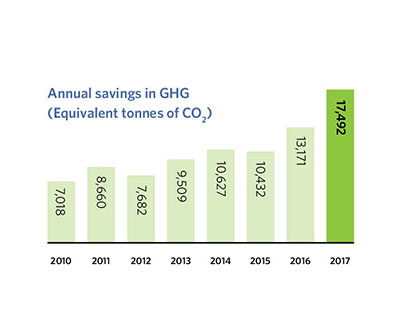Emissions down every year since 2009
NAIT has cut greenhouse gas emissions by 85,000 tonnes since 2009 – the equivalent of pulling 18,000 passenger vehicles from the road for a year. The savings are in spite of a major growth spurt that saw NAIT’s total square footage jump by 24% in recent years.
 Robert Akkerman, director of facilities management, says NAIT has committed to shrinking its carbon footprint compared to baseline data gathered in 2009. That means constructing more energy-efficient buildings, retrofitting older facilities, and in some cases switching energy sources.
Robert Akkerman, director of facilities management, says NAIT has committed to shrinking its carbon footprint compared to baseline data gathered in 2009. That means constructing more energy-efficient buildings, retrofitting older facilities, and in some cases switching energy sources.
“This helps to keep our greenhouse gas emissions in check, whether they’re emitted on site by using natural gas for heating or at the source by using electricity,” Akkerman says.
2017 a banner year for CO2 reductions
Last year was NAIT’s most successful year-over-year reduction, according to statistics shared this month during Earth Awareness Day, a sustainability-focused event for students and staff.
 The polytechnic cut emissions by 17,000 tonnes in 2017, reducing its carbon footprint to the equivalent of 43,739 tonnes of CO2. Equivalency refers not only to CO2 emissions but also greenhouse gases such as methane, nitrous oxide and other halocarbons.
The polytechnic cut emissions by 17,000 tonnes in 2017, reducing its carbon footprint to the equivalent of 43,739 tonnes of CO2. Equivalency refers not only to CO2 emissions but also greenhouse gases such as methane, nitrous oxide and other halocarbons.
To put this into perspective, NAIT contributed about 3.1 tonnes of emissions per full-load student per year. In Canada, the total emissions per person, per year is 20.1 tonnes, according to a federal report, Canadian Environmental Sustainability Indicators: Greenhouse Gas Emissions.
The majority of last year’s emissions, 28,391 tonnes or 65%, were sourced from electricity, while natural gas accounted for 14,348 tonnes (35%).
Since benchmark data was set in 2009, when NAIT’s campuses were consolidated into current configurations, energy intensity – the amount of energy used per square metre – has dropped 30%.
Newer, greener buildings
Part of the greenhouse gas savings can be attributed to increased energy efficiency in NAIT’s newer buildings, along with retrofits to older facilities. New construction in recent years has increased NAIT’s overall building footprint by almost a quarter to 290,000 square metres.
At 51,600 square metres, the Centre for Applied Technology was built to LEED Gold standards when it opened in 2016. It was also NAIT’s first building to have 100% LED lighting.
 The Productivity and Innovation Centre, which also aims for LEED certification when it opens this fall, will feature solar panels that can produce 67 megawatt hours of electricity per year.
The Productivity and Innovation Centre, which also aims for LEED certification when it opens this fall, will feature solar panels that can produce 67 megawatt hours of electricity per year.
Facilities replaced several aging air conditioning units that ran on steam power in favour of high-efficiency electric units. More than 90% of lights on Main Campus have also been converted to LED or T8 bulbs, a move that uses 25% to 30% less energy.
In future retrofits, Akkerman says his team will look to install more occupancy sensors that dim lights in unused rooms and upgrade ventilation systems to recover more heat from building exhaust air.